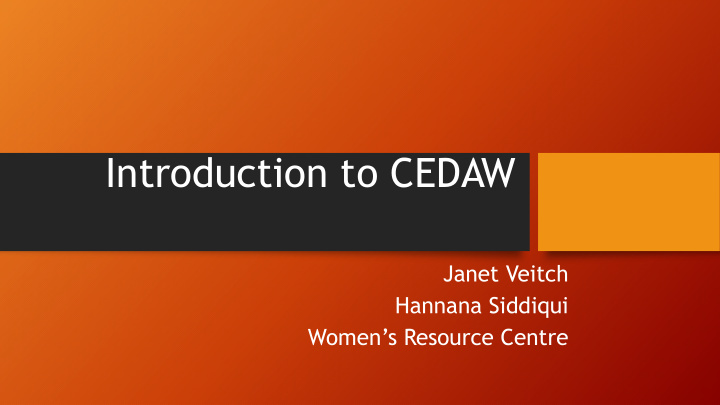



Introduction to CEDAW Janet Veitch Hannana Siddiqui Women’s Resource Centre
What is CEDAW? • CEDAW is the Convention on the Elimination of All Forms of Discrimination Against Women • a landmark international legal agreement adopted by the UN • It entered into force in 1981 after 20 countries had ratified (or agreed to be bound by) it • States must report progress every four years
CEDAW Committee • Assesses progress by states signed up to CEDAW • Issues general recommendations • Considers complaints from individual women or groups of women against states (the Optional Protocol) • Investigates widespread/systematic violations of women's rights
Role of state equality machinery • The Equality and Human Rights Commission is one of the UK’s three national human rights institutions (NHRIs) with ‘A’ status accreditation at the UN. • The EHRC gives the UN a ‘list of issues’ • The Government Equalities Office is responsible for producing the state report
CEDAW Committee: 23 women's rights experts • Read their previous recommendations, the state reports and shadow reports • Listen to evidence from states and NGOs • Question the Government • Make recommendations for action in their concluding observations
CEDAW SHADOW REPORTS • Engender Scotland • Women’s Equality Network Wales • Women’s Resource Centre England • Max 6,600 words – about 14 pages • Article by article OR thematic
Timeline • UK Government report sent to the UN December 2017 • Consultation on shadow reports February 2018 • Shadow reports sent June 2018 • ‘List of Issues’ sent July 2018 • Committee meets and agrees key issues July 2018 • State reply/updated shadow reports Oct-Jan 2019 • Committee examines the UK February 2019 • Concluding observations issued March 2019
CEDAW Committee’s last concluding observations • Better access to courts • Ratify the Istanbul Convention • Make forced marriage a crime • A national action plan on trafficking • Better mental health care in prison • End occupational segregation • Close the gender pay gap
Recommend
More recommend